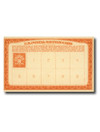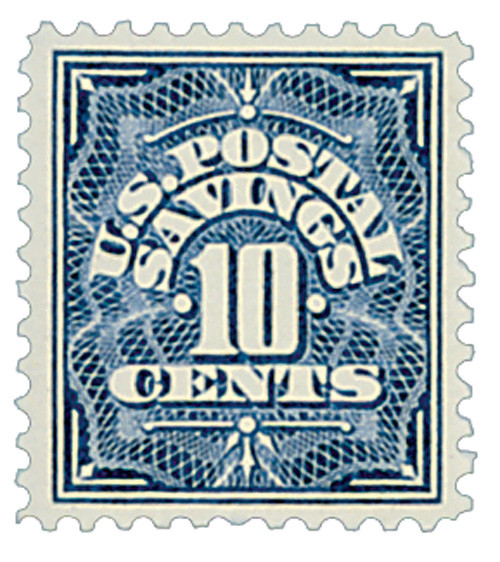
# PS2 - 1911 10c Postal Savings, orange, unwatermarked
US #PS2
1911 Postal Savings, Orange
• Same design as US #PS1, but imprinted on a deposit card with space for an additional nine 10¢ stamps
Stamp Category: Postal Savings (Back-of-the-Book)
Value: 10¢
First Day of Issue: January 3, 1911
Printing Method: Flat Plate
Format: Imprinted on deposit card (measures 137 x 79 mm)
Color: Orange
Watermark: Unwatermarked
Why the stamp was issued: Created as part of the Postal Savings System to serve small investors living in rural communities. Allowed lower- and middle-income individuals to deposit funds at their local post office. Stamps were given as proof of the deposit and were redeemable in the form of credits to Postal Savings Accounts.
About the stamp design: Pictures the same design as the very first Postal Savings stamp, but imprinted on a deposit card with space for an additional nine 10¢ stamps. The text above the area for the stamps reads “This card with nine 10-cent postal savings stamps affixed will be accepted by the postmaster at any postal savings depository office in the United States as a deposit of one dollar and placed to the credit of the depositor, either in opening an account or in adding to an existing account.”
History the stamp represents: President Theodore Roosevelt first promoted the Postal Savings System as a solution to public distrust of traditional banks. A congressional act established the system effective January 1, 1911. Under the act, the Postal Savings System paid two percent interest per year. The minimum deposit was $1.00 with a maximum of $500 initially, then later raised to $2,500.
The act also directed the Postmaster General to issue stamps in five denominations to be used instead of traditional Official Mail envelopes. The first of these stamps was issued on December 22, 1910. These stamps were used on mail pertaining to the business of the US Postal Savings System.
The Postal Savings System proved to be very popular among rural Americans and immigrants familiar with similar systems in their native countries. It was also popular with working people who were unable to conduct transactions during the limited hours of traditional banks. Postal Savings deposits could be made six days per week between the hours of 8 a.m. and 6 p.m. The system eventually extended to over 5,000 post offices in 48 states.
Though the Postal Savings System continued for years to come, the official stamps were discontinued in 1914. Postmasters were instructed to return the unused stamps, which were destroyed.
US #PS2
1911 Postal Savings, Orange
• Same design as US #PS1, but imprinted on a deposit card with space for an additional nine 10¢ stamps
Stamp Category: Postal Savings (Back-of-the-Book)
Value: 10¢
First Day of Issue: January 3, 1911
Printing Method: Flat Plate
Format: Imprinted on deposit card (measures 137 x 79 mm)
Color: Orange
Watermark: Unwatermarked
Why the stamp was issued: Created as part of the Postal Savings System to serve small investors living in rural communities. Allowed lower- and middle-income individuals to deposit funds at their local post office. Stamps were given as proof of the deposit and were redeemable in the form of credits to Postal Savings Accounts.
About the stamp design: Pictures the same design as the very first Postal Savings stamp, but imprinted on a deposit card with space for an additional nine 10¢ stamps. The text above the area for the stamps reads “This card with nine 10-cent postal savings stamps affixed will be accepted by the postmaster at any postal savings depository office in the United States as a deposit of one dollar and placed to the credit of the depositor, either in opening an account or in adding to an existing account.”
History the stamp represents: President Theodore Roosevelt first promoted the Postal Savings System as a solution to public distrust of traditional banks. A congressional act established the system effective January 1, 1911. Under the act, the Postal Savings System paid two percent interest per year. The minimum deposit was $1.00 with a maximum of $500 initially, then later raised to $2,500.
The act also directed the Postmaster General to issue stamps in five denominations to be used instead of traditional Official Mail envelopes. The first of these stamps was issued on December 22, 1910. These stamps were used on mail pertaining to the business of the US Postal Savings System.
The Postal Savings System proved to be very popular among rural Americans and immigrants familiar with similar systems in their native countries. It was also popular with working people who were unable to conduct transactions during the limited hours of traditional banks. Postal Savings deposits could be made six days per week between the hours of 8 a.m. and 6 p.m. The system eventually extended to over 5,000 post offices in 48 states.
Though the Postal Savings System continued for years to come, the official stamps were discontinued in 1914. Postmasters were instructed to return the unused stamps, which were destroyed.













